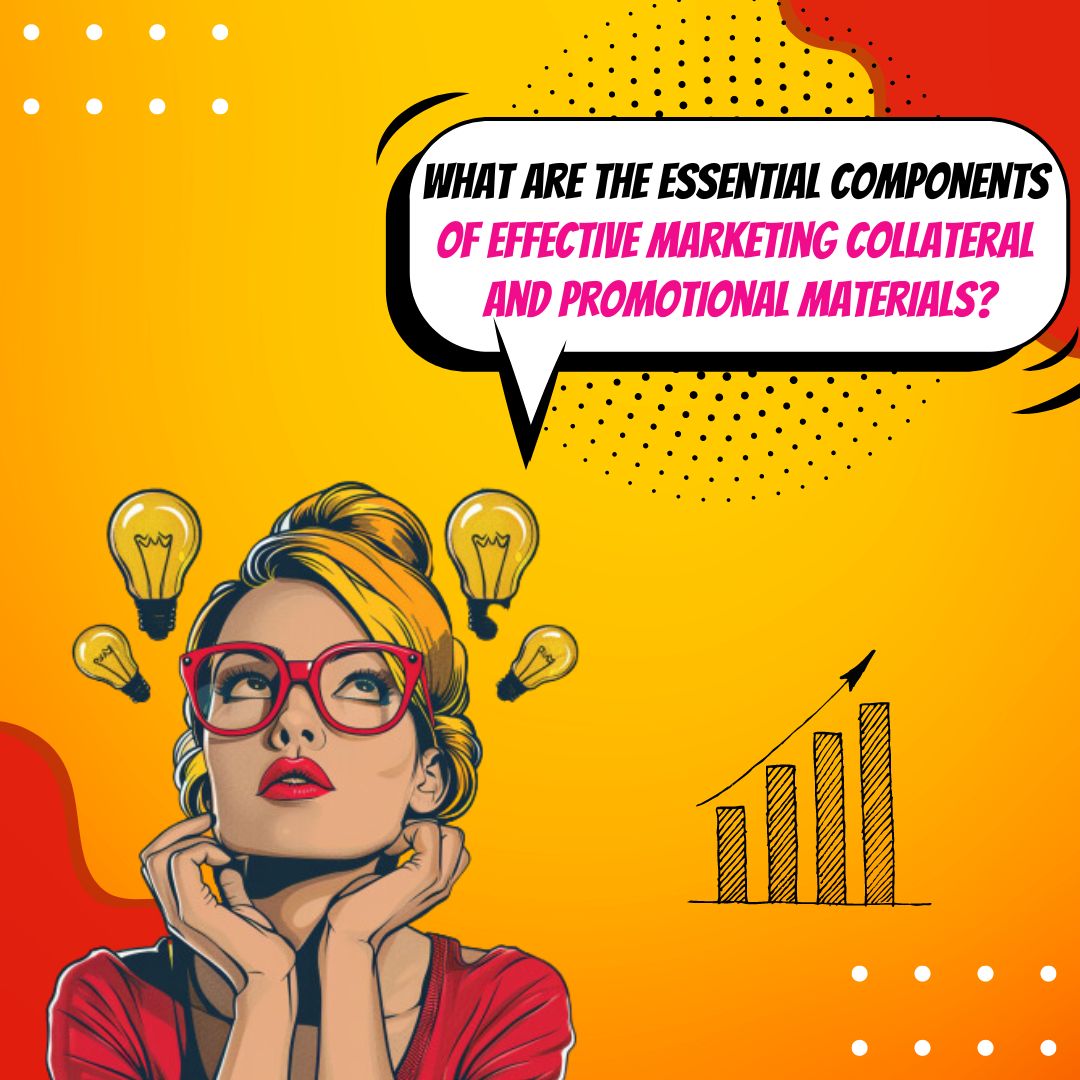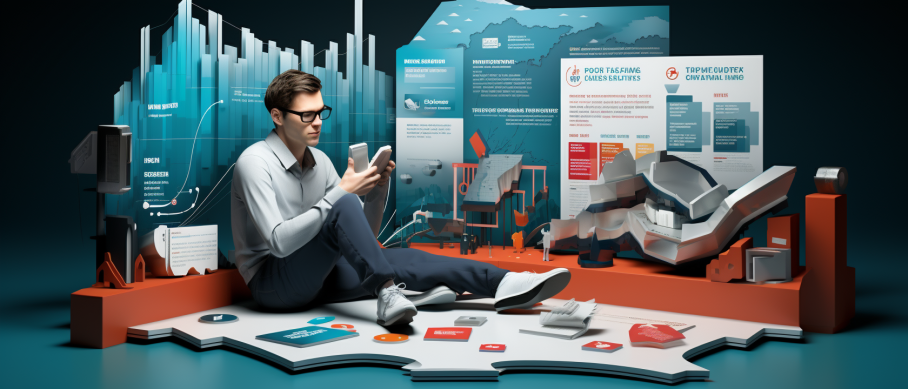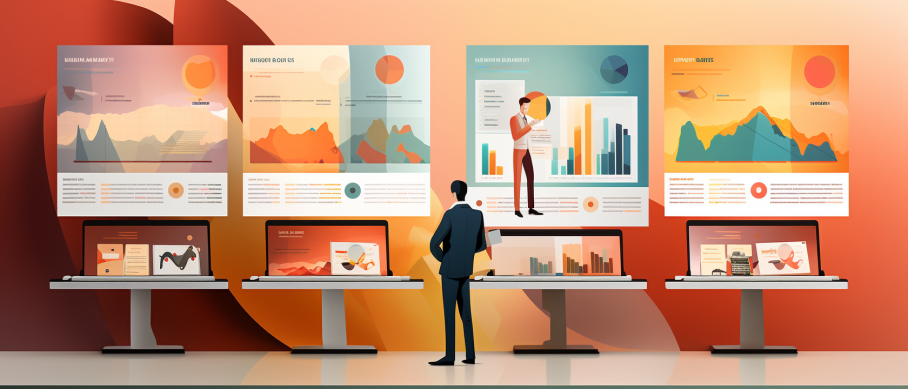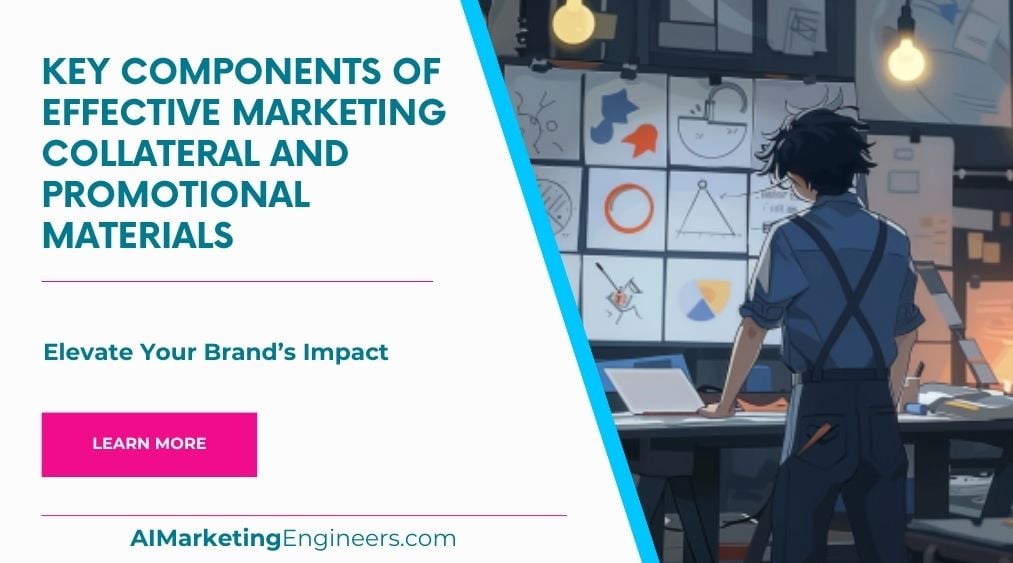Key Takeaways
✅ Visual Appeal: It turns out that people remember 65% of visual content up to three days later, compared to 10% of written content. So, ensuring the visual appeal of your marketing collateral isn't just a nice-to-have; it's a must-do. Opt for top-notch images and a design that captures the essence of your brand to leave a lasting impression.
✅ Clear and Concise Messaging: Did you know that the average attention span is only 8 seconds? That means your messaging must be as clear and concise as possible to make an impact. Your content should articulate what's in it for the customer quickly and engagingly.
✅ Consistency and Branding: Brands that are presented consistently see an average increase in revenue of 23%. Maintaining consistency and branding across all your materials can instill trust and improve recognition. Keep the same tone, style, and visual theme to strengthen your brand identity.

Introduction
Ever wonder why some brands just seem to stick in your mind? It's no coincidence—it’s the key components of effective marketing collateral and promotional materials at play. But what turns a mere pamphlet into a conversion powerhouse? Are you using visuals that captivate, messages that resonate, and branding that builds loyalty?
By leveraging modern trends and innovative perspectives, this article will guide you through creating materials that not just inform but inspire action. Imagine improving your revenue, ROAS, or ROI just by refining your marketing approach. Stick with us to unlock actionable insights and groundbreaking information that will change the way you think about marketing collateral.
Understanding Your Audience
Before you even start sketching out designs or drafting copy, you've got to know who you're talking to. Imagine trying to strike up a conversation without knowing a thing about the person you're addressing. Sounds tough, right? That's where audience analysis comes into play. Discover who your potential customers are by examining their age, location, buying habits, and even the challenges they face. These insights transform into a compass, guiding the creation of marketing materials that speak directly to those you're trying to reach. Statistics show that tailored content can increase customer engagement, as a study by McKinsey found personalized approaches can deliver five to eight times the ROI on marketing spend.

Compelling Design and Visuals
They say a picture is worth a thousand words, and in marketing, it may be worth even more. Imagine leafing through a magazine or scrolling online—what makes you stop and look? Eye-catching visuals. The design should be more than just pretty; it needs to capture attention, evoke emotion, and make people want to learn more. Remember, with just the right blend of photos, graphics, and typography, your message can go from a whisper to a shout, without overwhelming your audience. Reports suggest that content with relevant images gets 94% more views than content without relevant images.
Clear and Concise Messaging
Ever been stuck in a conversation that drags on with no end? That's exactly what you want to avoid in your marketing materials. Make sure your message is clear and to the point, delivering the punchline without any fluff. This doesn't mean your content needs to be devoid of personality—quite the contrary. It should just be easily digestible, enabling your audience to quickly understand your offering and its value. Studies indicate consumers remember only 10% of information three days after hearing it, but if a relevant image is paired with that same information, retention jumps to 65%.
Consistency with Brand Identity
Think of your favorite brands. There's a good chance you can picture their logos, the colors they use, and even their font choices. That's not by accident. Consistent brand identity across all marketing collateral reinforces your brand presence in the market. It's like seeing a familiar face in a crowd; it fosters recognition and trust. Consistency can contribute to brand recognition, which can account for as much as 10-20% of a company's market valuation.

Call-to-Action (CTA)
A good conversation often ends with an exchange of numbers or making plans to meet again. In marketing, the equivalent is a solid call-to-action. Your CTA should be the beacon guiding your audience on what to do next—whether that's to subscribe, buy, learn more, or get in touch. It should stand out and provide clear instructions, paving the way for engagement or a purchase. Statistics highlight the importance of CTAs, noting that emails with a single call-to-action increased clicks by 371% and sales by 1617%.
Quality Content
The meat of any marketing effort is undoubtedly the quality content it contains. Imagine going to a five-star restaurant only to be served a reheated frozen meal. Not the experience you'd expect, right? Your content should deliver on your audience's expectations, featuring useful data, heartfelt stories, and genuine testimonials. It's not just fluff—it's providing real value that establishes your brand as a credible source. Content marketing gets three times more leads than paid search advertising, making it a heavyweight in the promotional arena.
Measuring and Optimizing
Lastly, consider this: If you don't know the score, how can you tell if you're winning the game? Tracking and analyzing how your materials perform is like having a scoreboard for your marketing strategy. By using analytics tools to measure key metrics, you’re able to see what's resonating with your audience—and what's falling flat. This information is gold, allowing you to refine and improve your materials over time for better results. After all, companies that adopt data-driven marketing are more likely to have an advantage over the competition and increase profitability. In fact, they're six times more likely to be profitable year-over-year.

AI Marketing Engineers Recommendation
Recommendation 1: Leverage Personalization in Key Components of Effective Marketing Collateral: Data shows that personalization can lead to a 19% increase in sales. Tailor your marketing collateral to address the specific needs and interests of your target audience. Use customer data and analytics to create segmented and personalized materials that resonate more with recipients, whether in email campaigns, brochods, or digital ads.
Recommendation 2: Ensure Visual Consistency Across All Promotional Materials: Current trends emphasize the importance of brand consistency, with statistics indicating that consistent brand presentation across all platforms can increase revenue by up to 23%. Develop a standardized brand style guide that covers logos, color schemes, fonts, and imagery to be used systematically across all marketing materials, ensuring that your brand is instantly recognizable regardless of the medium.
Challenge 3: Incorporate Storytelling in Your Marketing Narratives: Storytelling isn't just a buzzword; it's a powerful tool. According to a study, messages delivered as stories can be up to 22 times more memorable than just facts. Integrate compelling stories into your marketing collateral that correspond with your brand values and connect on an emotional level with your audience. This approach can significantly enhance engagement and recall, making your promotional materials more impactful.
Relevant Links
- China's Digital Heartbeat: Unpacking the Power of WeChat for Marketing
- Breaking Into China's Short-Video Scene: A Brand's Guide to Douyin and Kuaishou
- Maximizing Engagement: Video Marketing Excellence in South Korea
- E-Commerce SEO Mastery: Driving Sales in South Korea's Digital Markets
- Decoding Chinese Consumer Behavior: Insights for 2024's Market Landscape
Conclusion
In wrapping up our deep dive into effective marketing collateral and promotional materials, it's clear that understanding your audience sits at the heart of successful campaigns. Remember, it's not just about what you want to say; it's about what they need to hear and how they prefer to hear it. When you pair that with compelling design and visuals, you not only catch the eye but also hold the attention of potential customers.
Now, with the stakes higher than ever in a crowded market, the importance of clear and concise messaging cannot be overstressed. Your brand's message must cut through the noise, delivering your value proposition in a way that is straightforward and, above all, easy to understand. Combine this with a well-crafted call-to-action (CTA), and your materials transform from informative to interactive, guiding your audience from interest to action.
Maintaining consistency with your brand identity is much like always wearing your team's colors – it fosters recognition and builds a strong, reliable presence. Moreover, the inclusion of quality content elevates your materials from mere advertisements to valuable resources, thereby fostering credibility and trust in your brand.
Lastly, let’s not forget the pillar of modern marketing – measuring and optimizing. Without analyzing the impact of your marketing collateral, you're navigating without a compass. Armed with data and insights, however, you can fine-tune your strategies for even greater success.
So, what do these insights mean for you and your marketing efforts moving forward? How will you apply these principles to ensure your collateral not only speaks to your audience but also spurs them into action? The ball is in your court; take these foundational blocks and build your brand’s future on them. After all, effective marketing collateral is more than just a means to an end – it's the vehicle that drives your brand's narrative and growth. Now, it's time to step into the driver's seat and hit the road to success.

FAQs
Question 1: What are marketing collateral and promotional materials?
Answer: Picture this: you're walking through a fair and someone hands you a shiny brochure about a new gadget, or you get a pop-up ad on your screen about an exciting event. That's marketing collateral and promotional materials! They're the stuff companies use to jazz up their sales and get their brand out there—like flyers, digital goodies, and those eye-catching giveaways you can't resist.
Question 2: What are the essential elements of effective marketing collateral?
Answer: Imagine your business as a puzzle. The pieces that make it complete include a brand that you can spot from a mile away, messages that stick in your head, graphics that captivate, and a clear shout-out to act on what you're seeing. All of this should tie back to the master plan—your overall marketing game.
Question 3: How important is brand consistency in marketing collateral?
Answer: Think about your go-to soda or sneakers. There’s a good chance you thought of them because they're consistent in their look and message. That's brand consistency for you—it's like the secret sauce for building trust and making sure folks remember your brand when it counts.
Question 4: What role does visual design play in effective marketing collateral?
Answer: Have you ever been stopped in your tracks by a stunning visual or a cool graphic? That's the power of design. It grabs your attention, gives your brand a personality, and helps tell your story in a way words alone can't match.
Question 5: How can I ensure my marketing collateral resonates with my target audience?
Answer: It's all about walking a mile in their shoes. Dive into what your audience loves, what gets under their skin, and what they’re searching for. Then, take that gold mine of info and sprinkle it across your marketing to make sure it speaks their language.
Question 6: What is a call-to-action, and why is it important in marketing collateral?
Answer: A call-to-action, or a CTA, is like a friendly nudge telling people what to do next. "Grab yours today!" "Sign up now!" It's that bit in the collateral that turns curious onlookers into buyers, subscribers, and followers.
Question 7: How can I measure the effectiveness of my marketing collateral?
Answer: Imagine your marketing collateral is a science experiment. To know if it worked, you track the reactions—how many people clicked, bought, or chatted about your brand. Tools like Google Analytics can be your best friend in measuring these reactions and tweaking your formula for success.
Question 8: What are some advanced techniques for creating effective marketing collateral?
Answer: Ready to be a marketing wizard? Use the magic of personalization, storytelling that captivates, content that gets people involved, and even dip your toes into futuristic stuff like augmented reality. It's about giving people an experience they won’t forget.
Question 9: How can I stay up-to-date with the latest trends in marketing collateral and promotional material?
Answer: Keep your ears to the ground and your eyes on the horizon. Follow gurus and clever blogs, get comfy in webinars, chat it up on social media—essentially, be where the action is. And don't forget to take a hard look at your own stuff to keep it fresh and competitive.
Question 10: What are some best practices for creating and distributing marketing collateral and promotional materials?
Answer: It all starts with a crystal-clear plan and a message that's all you. Add in content that's dope for your peeps, stick to your brand like glue, throw in some top-notch visuals, and never forget the golden rule: always tell them what to do next. Spread your message far and wide, and always check to see how it's flying with the crowd so you can keep getting better.

Academic References
- Zhivago, K., & Bly, R. W. (2017). The anatomy of effective B2B and B2C content marketing materials. Journal of Digital & Social Media Marketing, 5(1), 1-11. This study delves into the essential elements of successful business-to-business and business-to-customer content, underlining the necessity for materials to be clear, applicable, and consistent. Zhivago and Bly deliver pragmatic recommendations on content structure, visual attractiveness, and the incorporation of storytelling to captivate audiences.
- Kim, H.-J., & Lee, D.-J. (2011). Designing effective promotional materials: A review of empirical studies. Journal of Promotion Management, 17(3), 313-332. Through an analysis of empirical research, this review illuminates how visual components, color choices, typography, and overall layout wield influence on consumer perceptions and actions. Kim and Lee advocate for promotional materials that are not only visually engaging but also coherent with the brand's identity.
- Hackley, R. S., & Gutek, M. T. (2017). The role of emotional appeals in marketing communications: A critical review of thirty years of research. Journal of Advertising, 46(2), 189-212. In this critical examination, Hackley and Gutek dissect the influence of emotional appeals in marketing, considering their effect on consumer behavior and their efficacy in promotional content. The authors spotlight the imperative of employing emotional appeals to forge memorable and convincing marketing communications.
- Hollebeek, L., & Gummesson, E. (2018). The impact of personalization on consumer response to promotional materials. Journal of Marketing Communications, 24(2), 137-156. This work investigates personalization and its effects on consumer reaction to promotional materials, exploring its bearing on attitudes, engagement, and intent to purchase. Hollebeek and Gummesson posit that personalization, when done right, can amplify consumer engagement and allegiance.







